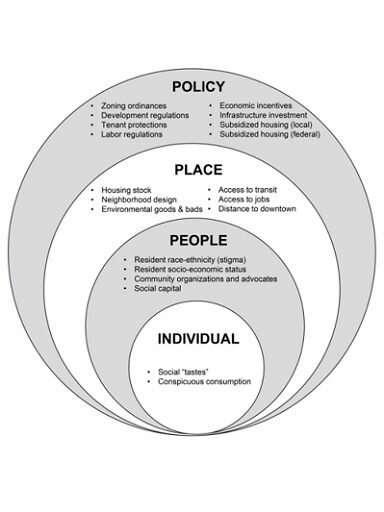A sociological model of gentrification. Credit: Journal of Urban Affairs
A new research model allows urban planners, policymakers and community leaders to better focus resources to limit gentrification in vulnerable neighborhoods throughout the U.S.
By examining the "people, place and policy" factors that determine whether a neighborhood will gentrify or not, the model offers a better understanding of what fosters gentrification and what limits it. This process reveals the roles that government and policy can proactively play in limiting its most damaging impacts.
"This model is a new way of thinking about what influences gentrification and how to prevent it," said study co-author Jeremy Németh, Ph.D., associate professor of Urban and Regional Planning at the University of Colorado Denver. "This study debunks the argument that gentrification is an uncontrollable consequence of market forces, and outlines specific strategies where communities have real power to limit it."
Public agencies, nonprofits and city governments with limited resources can use publicly available data to model gentrification likelihood, establish early warning systems and then develop prevention strategies for their communities.
The study, "Toward a socio-ecological model of gentrification: How people, place, and policy shape neighborhood change," is published in the Journal of Urban Affairs.
"We're offering the model as a tool for city governments and anti-gentrification actors to be more proactive in targeting proven interventions in the most vulnerable neighborhoods," said Németh, who co-authored the paper with Alessandro Rigolon, assistant professor of Recreation, Sport, and Tourism at the University of Illinois at Urbana-Champaign.
Predicting gentrification
The researchers tested the predictive gentrification model in the five most populous U.S. regions: Chicago, Los Angeles, New York City, San Francisco and Washington, D.C.
Three "place" factors—access to jobs, proximity to transit stations and the quality of housing stock—emerged as strong predictors of a neighborhood's likelihood to gentrify across all regions. As they heavily influence these place factors, this points to the critical role urban planners play in shaping gentrification forces.
The diversity of a neighborhood is the "people" factor with the strongest predictive value, the study found.
"We know from years of research on implicit bias that if a neighborhood has a very high share of Black or Latinx residents, it is much less likely to gentrify than one with a mix of several racial or ethnic groups," said Németh. He and Rigolon said they weren't surprised by the finding that racial/ethnic diversity is a strong predictor of gentrification.
Proven policy interventions
Although these factors weren't tested in this national-level study, several recent studies in California have shown that local "policy" strategies proven to slow gentrification include rent controls, community land trusts, and anti-eviction ordinances.
This first-of-its-kind study offers communities a model to identify the neighborhoods most vulnerable to gentrification and a roadmap to implement proven anti-gentrification strategies before it's too late.
For this research, gentrification is defined as the influx of middle- and upper-class residents in a spatially concentrated fashion, which often results in the displacement of long-time residents, who disproportionately are poorly educated, lower-income people of color.
More information: Alessandro Rigolon et al. Toward a socioecological model of gentrification: How people, place, and policy shape neighborhood change, Journal of Urban Affairs (2019). DOI: 10.1080/07352166.2018.1562846
Provided by University of Colorado Denver























